Aries (Mesha)
Aries, resembles the shape of horns of sheep, when stars in this constellation are imaginarily connected, as per Indian mythology!
Where should I see…Pisces, is the constellation which is towards west of Aries constellation.
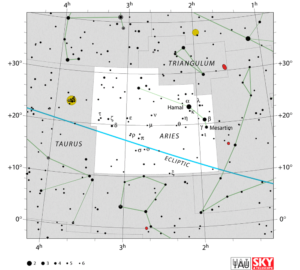
If you move your eyes towards east, you will see another constellation named Taurus. In the North of Aries, you will find Perseus and Triangulum and in South, Cetus constellations respectively. Aries is halfway between celestial equator and North Pole, and so is fully part of Northern Hemisphere.
It covers up 441 square degree area of the sky. Area wise it is 39th largest constellation in the sky.
When and What can I see…It is on the zodiacal belt and is the 1st zodiac on the zodiac belt. Sun enters in
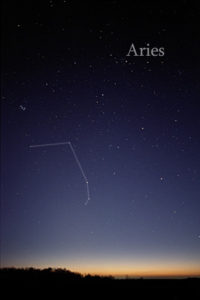
this constellation from 19th April to 15th May. It is best observed during July to March, as seen from India.
All you need is your naked eyes other than clear skies to see 83 stars of this constellations, as they are the one which are brighter than the lower limit of our naked eyes (i.e. 6.5 apparent magnitude) to see faintest stars. The brightest star of this constellation is Hamal, which is also called as Ashwini as per Hindu name. It is known as Nakshatra (lunar mansion). Besides there is a star in Aries named 41-Arietis whose Hindu name is Bharani, which is also known as Nakshatra (lunar mansion).
Constellations are made up of single, binary (apparent and absolute), multiple and variable stars.
Out of total 83 stars of different types, here is the list of 20 brightest stars as per their nature:
| Binary / Multiple Star system | Variable Stars | Binary / Multiple and Variable Stars | Single stars |
| 2 | Hamal | Bharani | Lilii Borea |
| – | Sheretan | Mesarthim | 7 |
| – | Botein | 4 | – |
| – | 1 | – | – |
| 2 | 4 | 6 | 8 |
In Indian mythology, it is said that when Rishis and Philosophers first saw Mesha tara mandal (Aries constellation) which is named as 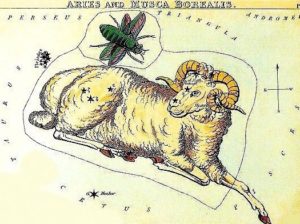 Mesha by them, actually looked like a shape of a horse tamer. Actually, there are many stories associsated with Mesha. But one of them is that, Ashwini learned Madhur Vidhya from Rishi Dadhichi. At the time Indra warned Rishi Dadhichi that if he gave his knowledge to anyone, then he will be beheaded. So Ashwini thought of replacing Dadhichi rishi’s head (that containts pure knowledge) with a horse head. So Indra replaced his head with a horse’s head and like this Rishi Dadhichi’s head with knowledge and wisdom was kept safe.
Mesha by them, actually looked like a shape of a horse tamer. Actually, there are many stories associsated with Mesha. But one of them is that, Ashwini learned Madhur Vidhya from Rishi Dadhichi. At the time Indra warned Rishi Dadhichi that if he gave his knowledge to anyone, then he will be beheaded. So Ashwini thought of replacing Dadhichi rishi’s head (that containts pure knowledge) with a horse head. So Indra replaced his head with a horse’s head and like this Rishi Dadhichi’s head with knowledge and wisdom was kept safe.
Deep Sky Objects…
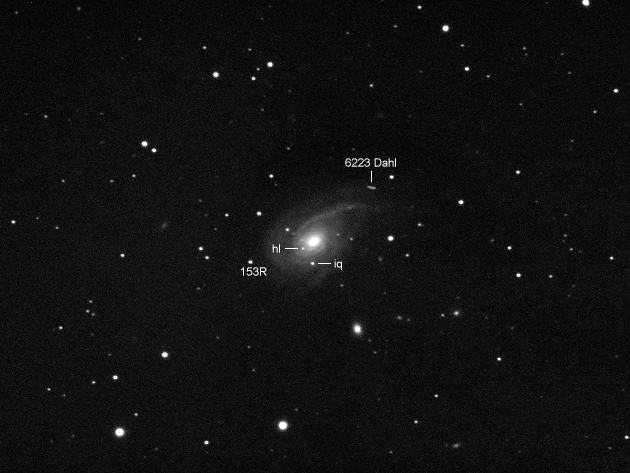 NGC 772 || unbarred spiral galaxy
NGC 772 || unbarred spiral galaxy
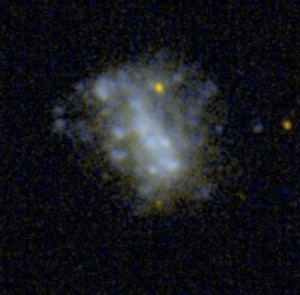 NGC 1156 || Dwarf Irregular Galaxy
NGC 1156 || Dwarf Irregular GalaxyAll the stars that we see naked eyes, all belong to our own, Milky way galaxy (Akash Ganga Tara Vishv). Bright stars can be seen naked eye and faint one through telescope. But the curtain of sky that we see in 2D is actually a huge universe we are talking about, with 3 dimension. There are many nebulous objects visible in every constellations. They differ widely by distances and nature. Like Emission Nebula, Reflecting Nebula, Absorption Nebula, Star Birth Nebula, Supernova Remnants (SNR) and Open Stars Cluster which are within the disk of our own Milky Way galaxy. Globular cluster are also found, which are in the halo of our galaxy and some most distant objects like galaxies are also visible through telescope. Such objects are defined as “Deep Sky Objects”.
In this constellation there are 151 such different types of Deep Sky Objects observed. Below is the list of 20 brightest Deep Sky Objects:
| Galaxy | Open Cluster | Globular Cluster | Nebula | Supernova Remnant | ||
| Naked eye visibility | – | – | – | – | – | |
| Visible through Telescope | 20 | – | – | – | – | |
| 20 | – | – | – | – |


